Testing Tribulations: Overcoming Common Testing Errors

Executive Summary

Testing is a crucial phase in software development that ensures the quality of software products. However, testing can be challenging, and several common errors can hinder its effectiveness. This article identifies and discusses these errors, providing practical strategies to overcome them and enhance the efficiency of testing efforts.

Introduction
Testing is an essential part of the software development process to identify defects or bugs within a software application. However, the testing process can often be plagued by common errors that reduce the accuracy and reliability of the results. To ensure the efficiency and effectiveness of testing efforts, it is essential to understand and overcome these errors.
Frequently Asked Questions
FAQ 1: What are the most common testing errors?
Answer: Incorrect test case design, inadequate test coverage, poor test environment management, inefficient automation strategies, and neglecting user feedback are some common testing errors.
FAQ 2: Why is it important to identify and overcome testing errors?
Answer: Unidentified and unresolved testing errors can lead to poor software quality, missed deadlines, increased costs, and reputational damage.
FAQ 3: How can I improve my testing skills and avoid common errors?
Answer: Continuous learning, regular practice, effective communication within the team, seeking feedback from peers and users, and adopting industry best practices can enhance testing skills and reduce errors.
Top 5 Subtopics of Common Testing Errors
Incorrect Test Case Design
Incorrect test case design occurs when test cases are poorly designed, making them ineffective or inadequate for identifying potential defects. It can stem from a lack of requirements understanding, incorrect implementation of test scenarios, or incomplete test coverage.
- Ensure clear requirements understanding: Test cases should be derived from well-defined and comprehensive requirements.
- Use appropriate test design techniques: Techniques like boundary value analysis, equivalence partitioning, or decision tables can help create effective test cases.
- Consider different scenarios: A variety of test cases should be designed to cover different scenarios and execution paths.
- Peer review test cases: Get feedback from fellow testers to identify and refine test case designs.
Inadequate Test Coverage
Inadequate test coverage occurs when testing does not cover all aspects of an application’s functionality or behavior, leading to undetected defects. It can result from insufficient time for testing, limited resources, or poor test planning.
- Prioritize test cases: Focus on testing essential features and functionalities first.
- Use automated testing tools: Leverage tools for automated smoke and regression testing to extend coverage.
- Map test cases to requirements: Ensure each requirement is covered by at least one test case.
- Involve stakeholders: Engage domain experts to identify critical areas for testing.
Poor Test Environment Management
Poor test environment management refers to issues in setting up, maintaining, and controlling test environments, which can impact the accuracy and consistency of testing results. It can arise due to unstable or unreliable test environments, inadequate resource allocation, or lack of test data.
- Establish a reliable test environment: Configure and maintain a stable test environment that simulates the production environment closely.
- Manage test data effectively: Ensure the availability of adequate and relevant test data for each test case.
- Monitor and control the environment: Implement mechanisms to monitor environment performance and identify potential issues.
- Communicate environment issues: Keep stakeholders informed of any test environment issues or limitations.
Inefficient Automation Strategies
Inefficient automation strategies involve implementing test automation without proper planning or consideration for long-term maintenance. It can lead to poorly designed automated tests, flaky or unreliable tests, and increased maintenance costs.
- Plan and prioritize automation: Select the right test cases for automation based on their criticality and complexity.
- Use a robust test automation framework: Choose a stable and maintainable framework to facilitate efficient test development and execution.
- Maintain automated tests regularly: Regularly review and update automated tests to align with changes in the application and requirements.
- Leverage reusable components: Create reusable components and libraries to enhance the efficiency of test automation.
Neglecting User Feedback
Neglecting user feedback refers to the failure to consider actual user experiences and feedback during testing, leading to a disconnect between real-world usage and the testing process. It can arise from limited user involvement, inadequate feedback collection channels, or lack of action on feedback received.
- Involve users in the testing process: Conduct user acceptance testing (UAT) to get feedback from real users.
- Establish clear channels for feedback: Create mechanisms for users to provide feedback throughout the development cycle.
- Analyze and prioritize feedback: Evaluate user feedback to identify pain points and areas for improvement.
- Communicate feedback to the team: Share user feedback with the development team to drive product enhancements.
Conclusion
Testing is a critical aspect of software development, and it is imperative to identify and overcome common testing errors to ensure the accuracy, reliability, and efficiency of the testing process. By understanding the causes and consequences of these errors, testers can develop strategies to mitigate their impact and improve the quality of their testing efforts. Continuous learning, effective communication, and the adoption of best practices are key to mastering the art of testing and delivering high-quality software products.
Relevant Keyword Tags
- Testing Errors
- Test Case Design
- Test Coverage
- Test Environment Management
- User Feedback